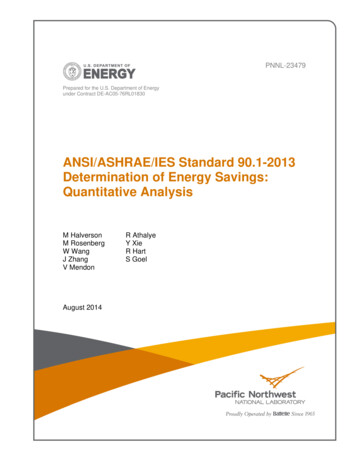
Transcription
Chapter OneJanuary 2013Chapter OnePerson-Centered Planning andPersonalized Recovery-Oriented Services (PROS)Person centered planning is.“A highly individualized comprehensive approach toassessment and services that is founded on an understanding of the person’s history,strengths, needs, and vision of his or her own recovery and includes attention toissues of culture, spirituality, trauma, and other factors.”--Institute of MedicineRecovery is person-driven: Self-determination andself-direction are the foundations for recovery asindividuals define their own life goals and design theirunique path(s) towards those goals. Individualsoptimize their autonomy and independence to thegreatest extent possible by leading, controlling, andexercising choice over the services and supports thatassist their recovery and resilience. In so doing, theyare empowered and provided the resources to makeinformed decisions, initiate recovery, build on theirstrengths, and gain or regain control over their lives.-- Substance Abuse and Mental Health ServicesAdministration (SAMHSA)(Guiding Principles of Recovery, SAMHSA’S WorkingDefinition of Recovery, f-recoveryupdated/(Crossing the QualityChasm, 2001)Person-centered recoveryplanning allows systems tomove away from a deficitbased approach to mentalillness diagnosis and treatmentdelivered by “experts” andmove towards a recoverybased model of collaboration,growth, and achievement. In arecovery-based model, theindividual becomes an equalpartner in the recoveryprocess. In New York State, Personalized Recovery-Oriented Services, or PROS, is acomprehensive, recovery-oriented program for individuals who are living with severe andpersistent mental health conditions. PROS strives to integrate person-centered planning intoeach facet of its design. Individuals are supported in realizing the recovery goals that they1
Chapter OneJanuary 2013define, using their personal strengths and abilities in conjunction with PROS services as tools toovercome the barriers that have been created by their mental illness.The goal of PROS is to help individuals to move beyond simply “managing” mental illness andmaintaining “clinical stability” and towards living full and productive lives within the context oftheir own unique personal goals and aspirations. The development of the “person-centeredplan” is the place where recovery and attainment of personal goals begins. PROS provides theframework for the recovery process; the person-centered plan provides the vehicle.Participation in PROS is outcome-focused. PROS providers support an individual’s personaljourney towards recovery by providing services targeted to help them overcome mental healthbarriers that stand in the way.In considering how to integrate Person-Centered Recovery Planning into practice, it can behelpful to focus on the four essential “Ps” that result in the fifth “P” -- an effective PROS: Philosophy: integration of person-centeredness into the way individuals, practitioners,and the provider agency as a whole consider and define recovery outcomes; Planning Process : a dynamic dialog between the person and practitioner thatidentifies, considers, and evaluates each person’s strengths, abilities, goals, and mentalhealth barriers; Plan (i.e., Individualized Recovery Plan (IRP)): the result of the planning process, theIndividualized Recovery Plan or “IRP” is a person-centered roadmap that the personfollows to recovery; the IRP documents the person’s goals and the medical necessity ofthe PROS services the person will use to achieve these goals; Product: recovery becomes a reality for individuals as they achieve their goals andovercome the barriers created by mental illness.Following the 4 Ps to PROS . Philosophy: a way of thinking and feeling Process: a way of doing Plan: the written IRP 2 role goals PROSProduct: recovery and achieving life
Chapter OneJanuary 2013PROS Combines Person-Centered Practices with a Recovery FocusRecovery is a deeply personal, unique process of changing one’s attitudes, values,feelings, goals, skills and/or roles. It is a way of living a satisfying, hopeful, andcontributing life even with limitations caused by the illness. Recovery involves thedevelopment of new meaning and purpose in one’s life as one grows beyond thecatastrophic effects of mental illness.--William Anthony(Recovery from Mental Illness: The Guiding Vision of the Mental Health Service System inthe 1990s, 1993)PROS and person-centered practices share the same foundation. In PROS, practitioners useperson-centered practices to: Provide a way for people to work together towards a recovery goal. Focus services and supports based on what is most important to the individual. Focus on strengths and capacities of the individual. Empower individuals to retain positive control over their lives. Involve family members/ friends/ others as full partners. Support an individual’s inclusion in community activities and decisionsSAMHSA identifies the following Principles of Recovery: Person-driven; Occurs via many pathways; Holistic; Supported by peers; Supported through relationships;3
Chapter OneJanuary 2013 Culturally-based and influenced; Supported by addressing trauma; Involves individual, family, and community strengths and responsibility; Based on respect; and Emerges from hope.Recovery-oriented care builds on the strengths and resiliencies of individuals, their families andtheir communities, using services and supports that are person-centered, prompting real andmeaningful changes in the treatment planning process. Person-Centered Recovery Planningmust be embedded in a system of care that is committed to changing not only what people do(e.g., in the practice of Person-Centered Recovery Planning) but also how people think andfeel about recovery and their obligation to partner with participants to achieve it.The History of Person-Centered PlanningPeople in recovery have long been speaking out against assumptions that“to be mentally ill” means to have lost the capacity for sound reasoning orthe capacity to take responsibility for their treatment and other major lifedecisions.-- PE Deegan(The Independent Living Movement and people with psychiatricdisabilities: Taking control back over our own lives, 1992).Person-Centered Recovery Planning is informed by many sources, particularly the experiencesof individuals who have “survived” the limitations of traditional models of care and who havecalled for a radical change toward more Person-Centered Recovery Planning models. Inaddition, the vision of Person-Centered Recovery Planning in the mental health field is built onsimilar efforts in other disability fields, e.g., Whole Life Planning (Butterworth et al., 1993),Lifestyles Planning (O’Brien, 1987), McGill Action Planning System (Vandercook, York & Forest,4
Chapter OneJanuary 20131989), and Personal Futures Planning (Mount & Zwernik, 1988). Although each of theseapproaches in the developmental disabilities field is somewhat unique, they all share thefollowing: When the therapist asked me, “So how can IThe primary direction in the planningbest be of help?” I thought, “Oh great, I’veprocess comes from the individual orhis/her family/designated other, when thereally got a green one. You are supposed to bethe professional–you tell me!” But I get it now. Iindividual is under age or incapacitated,need to decide what I need to move ahead inand the family/other is empowered tomy recovery. And I needed to know it was OKspeak on his/her behalf.to ask people for that. That was the key. There is involvement of significant others--Tondora & Davidson,and a reliance on personal relationships(Recovery Practice Guidelines, 2006).as the primary source of support. There is a focus on capacities and assets rather than on limitations and deficits. There is an emphasis on promoting access to inclusive community settings. There is an acceptance of uncertainty, setbacks and disagreements as natural elementsin the path to self-determination.The Person-Centered Recovery Planning ProcessThe plan of care will be at the core of the consumer-centered,recovery-oriented mental health system. The plan will include treatment,supports, and other assistance to enable consumers to better integrate intotheir communities and to allow consumers to realize improved mental healthand quality of life.Department of Health and Human Services (DHHS) New Freedom Commission on Mental Health(Achieving the Promise: Transforming Mental Health Care in America, 2003)5
Chapter OneJanuary 2013For providers and practitioners, Person-Centered Recovery Planning means partnering withindividuals rather than directing them. In Person-Centered Recovery Planning, the individualidentifies and works to achieve goals that are personally meaningful, even when such goalsextend beyond those areas traditionally addressed by clinical mental health services. Forpeople receiving mental health services, Person-Centered Recovery Planning means havingchoices about the services they receive. It means selecting a recovery support team andinviting family and significant others to be a part of that team. It means realizing that the personhas the power and the tools to change his or her life.In the person-centered planning process, there is an emphasis on personal empowerment andmaximizing one’s ability to make life-defining decisions involving one’s living situation,relationships, vocation, education, and other areas of life. Individuals’ rights to selfdetermination are respected and individuals are afforded maximum opportunity to exercisechoice in the full range of treatment and life decisions.In an effort to support broad-based recovery goals and to offer people a flexible array ofsupports, the Person-CenteredTraditional mental health systems have beenRecovery Planning process valuesdescribed as tending to “surround people witha wide range of diverse supportsserious mental health problems with a sea ofincluding self-management, peerprofessionally delivered services . . . whichsupport, holistic medicine, culturalstigmatize them and set them apart from thehealers, among others. Informationcommunity.”about medications and othertreatments should be mingled withinformation about self-help, peer--- Nelson, Ochocka, Griffin & Lordsupport, exercise, nutrition, daily(“Nothing About Me, Without Me”: Participatorymaintenance activities, spiritualAction Research with Self-Help/Mutual Aidpractices and affiliations, supportedOrganizations for Psychiatriccommunity activities, homeopathicand naturopathic remedies, andConsumer/Survivors, 1998)more. Both traditional and nontraditional supports are madeavailable for people in the manner that best assists them in their recovery. Peer support takes6
Chapter OneJanuary 2013on a significant role. The experiences of peers are especially valuable in helping others who areexperiencing similar struggles. In some cases, this broad, individualized approach to treatmentplanning and supporting recovery may require significant creativity on the part of teammembers.Members of the individual’s natural supportnetwork often have essential information andsupport to offer. The natural support network“It made such a huge difference to havemay be comprised of family members,my pastor there with me at my planningfriends, acquaintances, co-workers, fellowmeeting. He may not be my father, but hechurch-goers, and others who are not paid tois the closest thing I’ve got. He knowsbe in the person’s life but who choose to beme better than anyone else in the worldbecause of a personal connection to theand he had some great ideas for me.”-- Tondora & Davisonindividual or family. A diverse team thatincludes both natural and professional (i.e.,(Recovery Practice Guidelines, 2006).paid ) support systems is more likely toidentify, define, and access supports,services, and activities that are both creativeand useful to the individual in his or her unique journey to recovery.Meaningful community life is not something that service systems can, or should, create forpeople in artificial microcosms. Person-centered recovery planning supports access to inclusivecommunity settings while seeking to reduce, or even better, eliminate time spent in segregatedsettings that have been designed solely to support people labeled with a mental illness. Whilespecialized service settings can play a pivotal role in an individual’s recovery, over prolongedperiods of time they tend to perpetuate a sense of chronic alienation (or “patient-hood”).Specialized settings that “isolate” the individual from his or her community also perpetuate astigmatizing view of mental illness and may contribute to discriminatory and unethical practiceson the part of community members. For example, it was at once common for mental healthsystems to offer sheltered workshops rather than real jobs for real pay or to offer movie nights atthe mental health center rather than passes to the local theatre. In PROS, services can andshould be delivered in community settings as much as possible so that individuals can begin torestore their confidence, connections, and natural support networks.7
Chapter OneJanuary 2013In Person-Centered Recovery Planning, individuals are presumed competent and entitledto make their own decisions. Responsible risk-taking and growth are valued steps inrecovery. Prior to imposing power or restrictions, providers try multiple ways of engaging theindividual. They support the dignity of risk (Deegan, 1996) and sit with their own discomfort asthe person tries the new experiences that are necessary for growth and recovery. Thepractitioner’s role is to work with the person to outline the range of options and their potentialconsequences rather than to dictate the experiences the person is “allowed” to pursue.Documenting Medical NecessityIn creating individualized service or recovery plans (IRP’s), providers must balance theindividual’s goals and preferences (the person-centered aspects) with legal requirements,regulatory requirements, organizational requirements, and the payment structures of medicalinsurance systems. It can often feel as if these are two opposing concepts and that providershave to serve “two masters”. (Adams & Grieder, 2005)Documentation in PROS should be created in partnership with persons in recovery whilemaintaining rigorous standards around treatment planning, medical necessity, and Medicaidcompliance.Contrary to the common myth that person-centered planning is “soft,” emerging practiceguidelines (Grieder & Adams, 2004) as well as PROS-specific regulations explicitly call for thedocumentation of:a) Comprehensive clinical formulations;b) Mental health-related barriers that interfere with functioning;c) Strengths and resources;d) Short-term, measurable objectives; ande) Clearly articulated interventions which identify the roles of the practitioner and theperson, the anticipated timeline of the intervention, and the anticipated outcome.8
Chapter OneJanuary 2013These documentation standards demand continuous scrutiny, oversight, and qualitymanagement. Subsequent workbook chapters will demonstrate that medical necessity andperson-centered care are not incompatible constructs.Using a Strength Based ApproachAll human beings need the opportunity and freedom to learn from their own mistakes.Therefore, in circumstances that do not pose serious and imminent risks to the person or toothers, direct supporters accordingly afford individuals “the dignity of risk” and “the right tofailure”--PE Deegan(Recovery as a Journey of the Heart, 1996)A strengths-based individualized recovery process should be seen as an opportunity to helppeople to rediscover themselves as capable persons with histories, futures, and strengths andinterests beyond the symptoms, deficits, or functional impairments the mental illness mayimpose. Such an approach allows providers to balance the person’s critical needs with theresources and strengths that he or she possesses to adapt to stressful situations, confrontenvironmental challenges, improve quality of life, and advance in recovery. A practitioner whofocuses on the deficits created by the mental illness often overlooks the inherent and mostvaluable resources the individual possesses. Emphasizing the negative in this way hashistorically led to a tremendous sense of hopelessness and despair among both individuals andthe practitioners who serve them.Following the 4 Ps to PROSIn the beginning of this chapter, we talked about the “4 Ps:” Philosophy, Planning Process, Plan,and Product. The first “P” – Philosophy – provides the foundation for an organization toimplement person-centered practices into the fabric of its practices. By integrating a9
Chapter OneJanuary 2013philosophy of person-centered planning into all aspects of the program, PROS providers areable to identify, understand, and facilitate each individual’s personal journey towards recovery.With this philosophy as a foundation, PROS providers partner with people to achieve goals thatare meaningful to them – goals that each person defines -- improve social skills (I want agirlfriend), realize independent living (I want to move out of the group home), restore theirfunctioning (I want to be the best father I can be), gain/regain employment (I want to get my jobback), and attain higher levels of education (I want to finish school someday). The “Product” oroutcomes that will result are best acknowledged by listening to the words of people who haveparticipated in PROS. “I used to be completely isolated from the world dealing with PostTraumatic Stress Disorder (PTSD), depression, and anxiety. The PROSprogram has helped me to get back into the world slowly.” “If it wasn’t for PROS, I would not have found a job - I really wanted towork. It makes me feel like I am worth something.”Words like these – words that reflect a positive outlook and a sense of hope and recoveryare often heard when PROS participants are asked about their experiences in PROS.In the following chapters, we will demonstrate how practitioners can use the remaining 3 Ps toinfuse their programs with person-centeredness and provide effective recovery-focused servicesthrough PROS.10
Chapter OneJanuary 2013Chapter highlights: Person-Centered Planning & PROS A philosophy of Person-Centered Recovery Planning is integrated into the waypeople and practitioners consider and define recovery A person-centered planning process includes a dynamic dialog between theperson and practitioner that identifies, considers, and evaluates each person’sstrengths, abilities, goals, and mental health barriers People receiving psychiatric treatment are able to decide their own recoverygoals A person-centered approach helps each individual move beyond simplymaintaining “clinical stability” to a recovery that is characterized by livinga full and productive life Person-centered recovery planning emphasizes connecting individuals withnatural supporters and community activities. The pursuit of hobbies and leisure activities can be an important part of therecovery process11
catastrophic effects of mental illness. --William Anthony (Recovery from Mental Illness: The Guiding Vision of the Mental Health Service System in the 1990s, 1993) PROS and person-centered practices share the same foundation. In PROS, practitioners use person-centered practices to:











